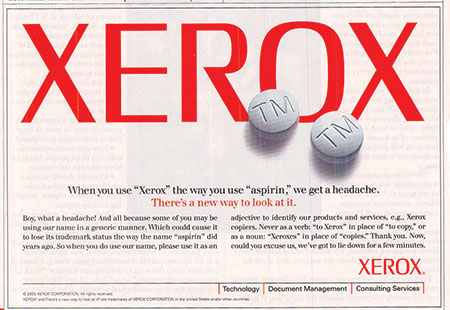When a trademarked brand name begins to be used as a common name and genericised through constant use, the phenomenon is known as trademark erosion aka genericide – Roopa Bannerjee
It is not uncommon to hear someone say ‘I need to make a Xerox of this’ or ‘Why don’t you cover it with Sellotape?’ When a trademarked brand name begins to be used as a common name and genericised through constant use, the phenomenon is called trademark erosion, aka genericide.
For instance we say Elevator for home and office lifts but that word is a brand name of the Otis Elevator Company. The Flip Phone is a trademark of Motorola but is now used to refer to any phone that flips open. Thermos refers to any vacuum flask but it was originally a trademark for flasks manufactured only by the Thermos Bottle Company. Sellotape is a British brand name but now refers to all transparent adhesive tapes. Lanolin, kerosene and trampoline are also instances of trademark erosion.
There are many brand names which were originally registered trademarks and yet became generic terms due to extensive use. They lost legal protection to such an extent that even competitors’ brands were referred to by their names and the company could do nothing about it. For instance, Aspirin is used as a generic in the US although it retains its trademark in 80 other countries. US court rulings in 1918 and 1921 decreed Aspirin to be genericised, stating that the pharmaceutical giant Bayer had failed to reinforce the company’s connection with the brand. A rare example of a company that successfully fought trademark erosion is the Japanese multinational video games company Nintendo, which managed to replace excessive use of its name by ‘game console’.
It is ironic that the more successful a brand, greater the likelihood of trademark erosion. It is as if the better a company is at building a brand, the less likely it is to own its trademark. Trademark erosion is now a subject of detailed study in B-schools. Today, to prevent trademark erosion, companies increasingly use generic descriptors while advertising their products.
For example, Kleenex uses the word tissues in its packaging, combining the generic word tissues with its brand Kleenex. The Internet search engine Google also did its best to circumvent trademark erosion by discouraging publications from using the term ‘googling’ in reference to web searches. In 2006, the Oxford English Dictionary struck a balance between acknowledging extensive use of the verb ‘to google’ and its trademark right by defining it as “use of the Google search engine to obtain information on the Internet”.
 There are many other registered trademarks which are used as general descriptors — i.e. Astro Turf, Coke and Dictaphone. When we hoover a room, we mean any vacuum cleaner but Hoover is actually a British company’s brand. When we photoshop an image, we aren’t always planning to use the Photoshop software developed by Adobe Inc. Many roads are coated with Tarmac, we think, without realising that Tarmac is a registered brand.
There are many other registered trademarks which are used as general descriptors — i.e. Astro Turf, Coke and Dictaphone. When we hoover a room, we mean any vacuum cleaner but Hoover is actually a British company’s brand. When we photoshop an image, we aren’t always planning to use the Photoshop software developed by Adobe Inc. Many roads are coated with Tarmac, we think, without realising that Tarmac is a registered brand.
What the road is coated with is asphalt. Xerox has used trademark awareness advertisements to prevent the brand from becoming a generic noun or verb, including tag lines such as ‘You can’t make a Xerox’.























